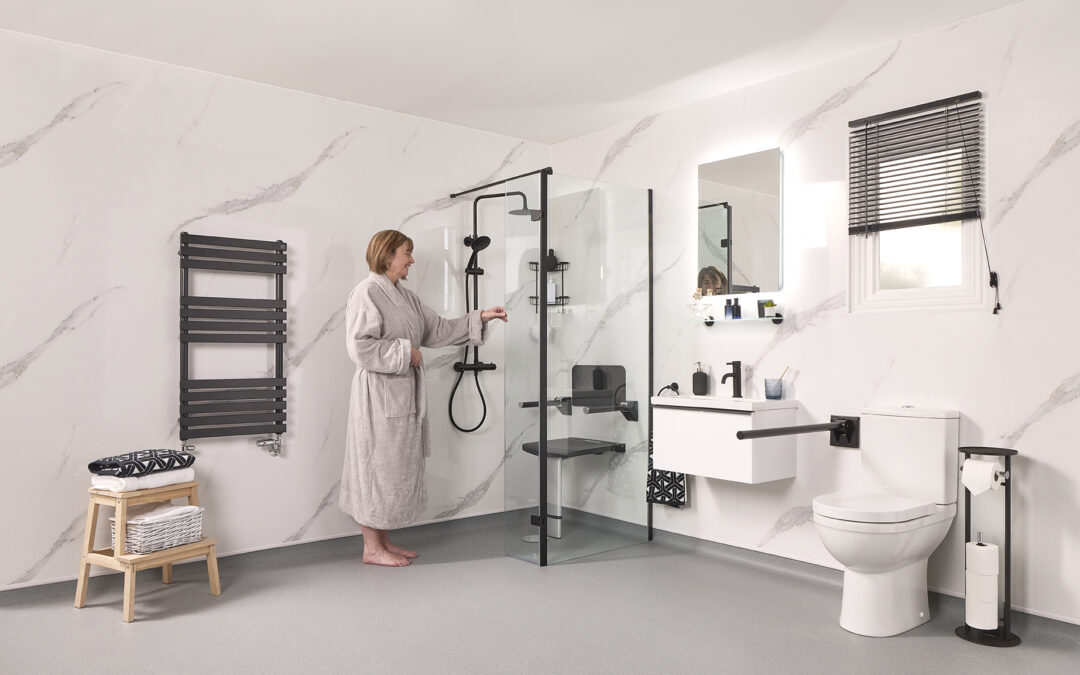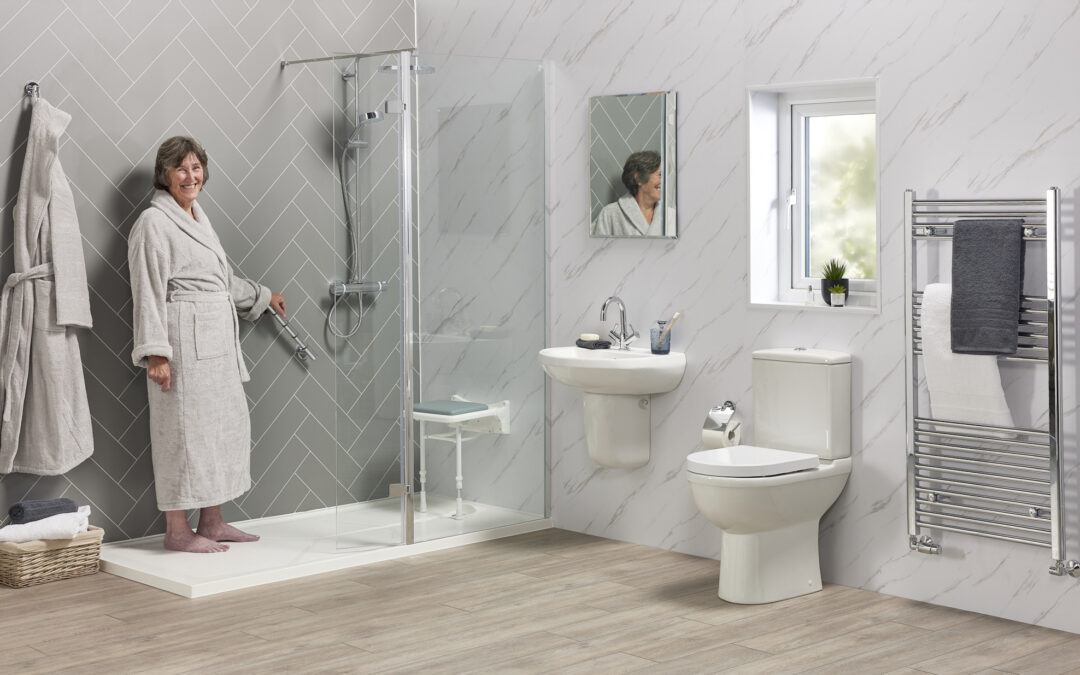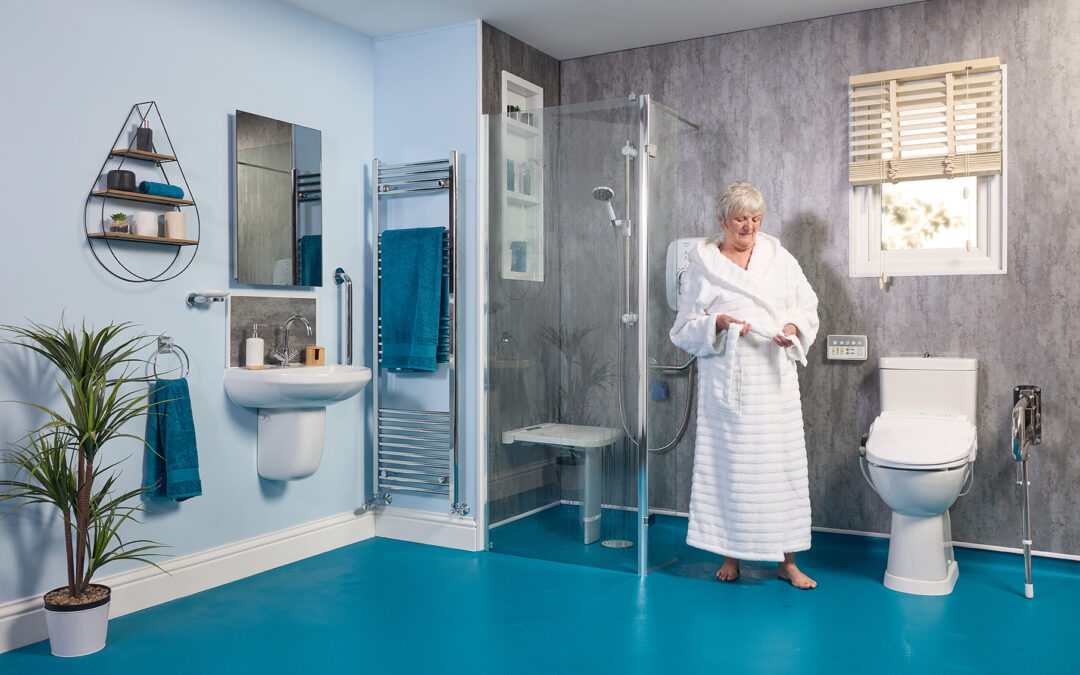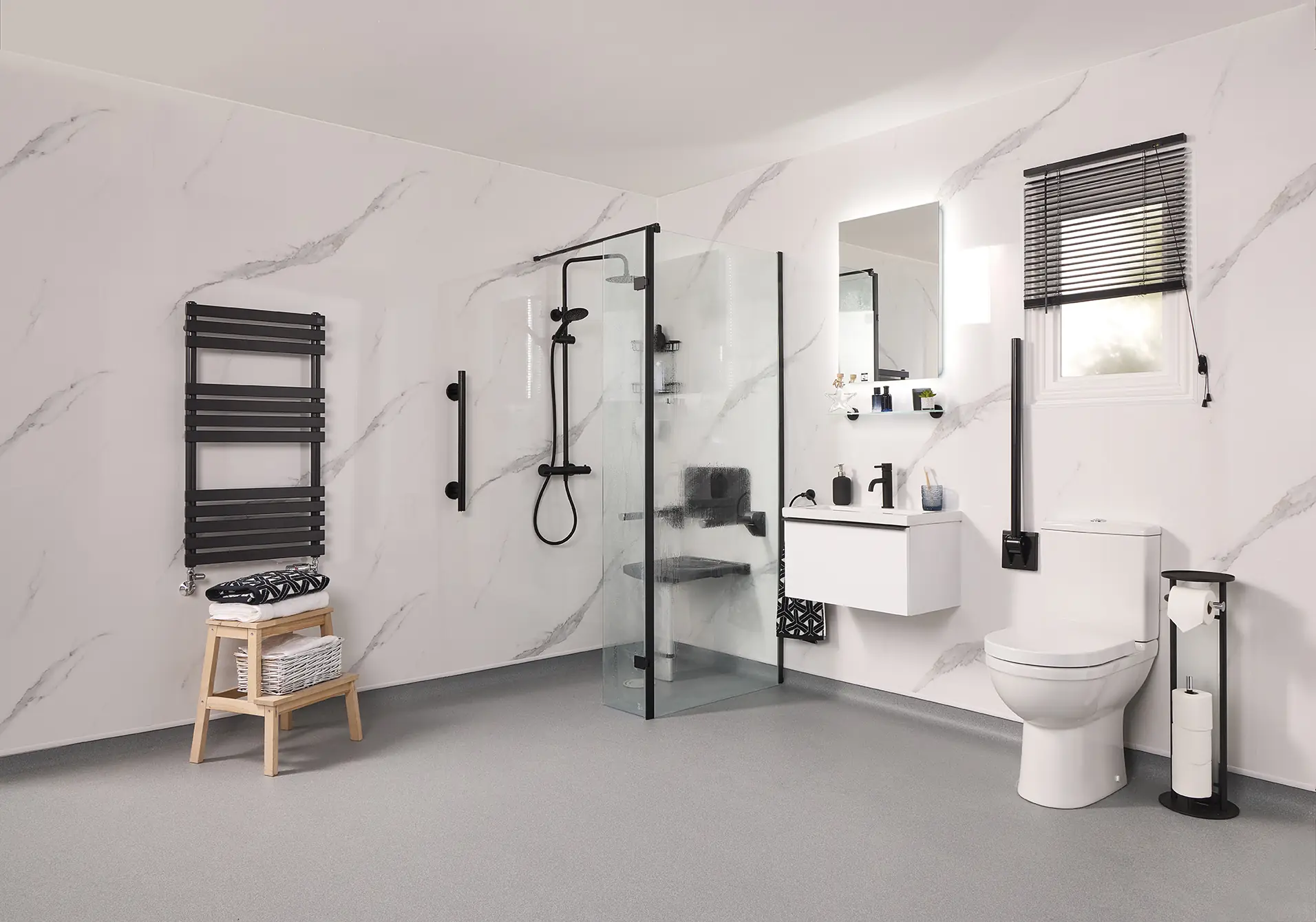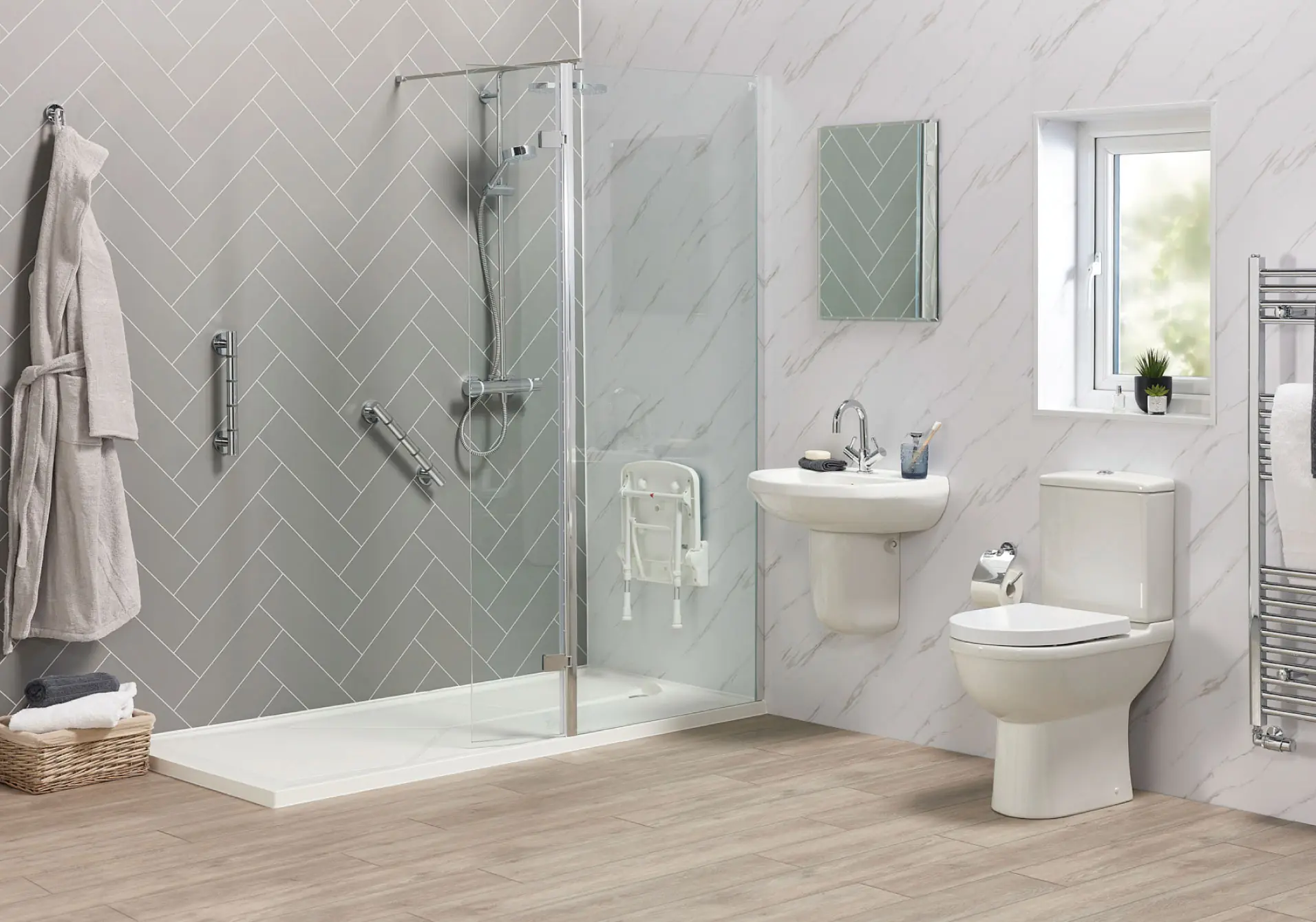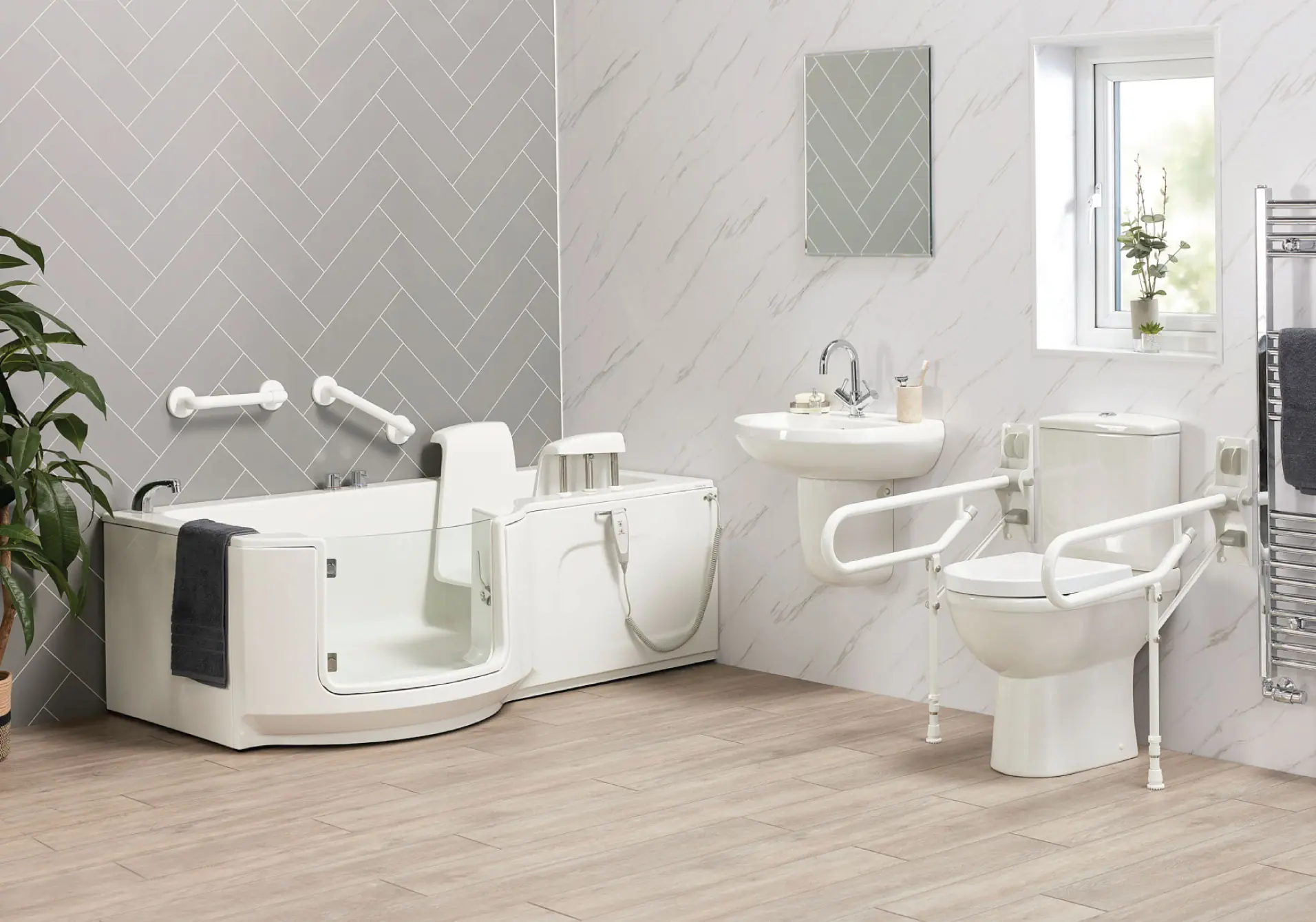Table of Contents
- Why bathrooms are risky (the UK picture)
- Grab rails & support bars (fit where they matter)
- Non-slip flooring (what “safe” means in the UK)
- Shower seating (reduce fatigue, improve control)
- Lighting & layout (see hazards, avoid splash)
- Ventilation (so the room stays dry and safe)
- Electrical safety (zones, IP ratings, RCDs)
- Daily habits that cut risk
- At-a-glance: Common hazards → Simple fixes
- Spec that actually prevents falls (must-haves)
- What “anti-slip” means (UK slip classification)
- Mini design guide (numbers that help)
- VAT (England)
- Safety checklist (print or save)
- FAQs
To-the-point
Bathrooms mix water + hard surfaces + tight spaces — a high-risk combo for older adults. Your biggest wins: level access, wet-rated anti-slip flooring (PTV ≥36), grab rails at entry/seat/exit, a fold-down shower seat, bright, even lighting, quiet mechanical ventilation (Part F), and simple daily habits (dry floors, de-clutter, regular cleaning for grip). Back this with proper installation and periodic reviews.
Why bathrooms are risky (the UK picture)
-
Falls prevalence: ~1 in 3 people aged 65+, and ~1 in 2 aged 80+ fall at least once a year. In England, there were ≈210,000 emergency admissions due to falls among people 65+.
-
What drives risk here: wet, slippery surfaces; glare/low light; cramped layouts; fatigue; rushing to the toilet at night; medicines that affect balance.
Grab rails & support bars (fit where they matter)
-
Put rails at the entry, seat, and exit points; test reach standing and seated.
-
Fix into solid structure (or use proper wall reinforcement); avoid suction cups as primary support.
-
Warm-touch finishes build confidence. NHS/health building guidance consistently references grab rails as an effective control when correctly positioned and fixed.
Non-slip flooring (what “safe” means in the UK)
Choose surfaces that are wet-rated and keep them clean so the texture works. In UK testing, PTV ≥36 (Pendulum Test Value) indicates low slip potential in wet areas — ideal for showers and near basins. (HSE/UKSRG & GRIP scheme).
Shower seating (reduce fatigue, improve control)
A fold-down seat helps with stability and energy. Check height, reach to controls (while seated), and drainage under the seat. NHS/OT materials recommend sitting to wash if transfers or stamina are an issue.
Lighting & layout (see hazards, avoid splash)
-
Use bright, even lighting with minimal glare; add a night-light for evening visits.
-
Put controls near the entry so water turns on before you step in.
-
Aim the shower head inward and add a return/deflector panel to contain spray.
-
Keep routes clear; store essentials at reachable heights.
Ventilation (so the room stays dry and safe)
Mechanical extract helps keep floors, grout and seals dry (less slime, more grip). Approved Document F sets typical bathroom rates of 15 l/s (intermittent) or 8 l/s (continuous “high rate”). Keep a clear airflow path (e.g., under-cut door); commission the fan.
Electrical safety (zones, IP ratings, RCDs)
-
Bathrooms have safety zones 0/1/2. In zones 1–2, equipment should be IPX4+; if likely exposed to jets, IPX5.
-
All bathroom circuits (lights, showers, towel rails) require 30 mA RCD protection; 230 V sockets must be ≥3 m horizontally from zone 1. (IET, BS 7671 Section 701 explainer).
Daily habits that cut risk
-
Wipe up water immediately; keep a squeegee handy.
-
De-clutter: remove loose mats and trailing leads.
-
Clean surfaces: soap/shampoo residues reduce grip.
-
Stay active: NHS balance/strength exercises improve stability and confidence.
At-a-glance: Common hazards → Simple fixes
| Hazard | Quick fix |
|---|---|
| Wet, slick floor | Wet-ratedanti-slip surface (PTV ≥36); daily wipe-down; gentle, regular cleaning. |
| Spray outside the shower | Add a return/deflector; point head inward; level access without pooling. |
| Hard transfers | Grab rails at entry/seat/exit; fold-down seat; reachable controls. |
| Night-time trips | Night-light path; clear floor; non-slip. |
| Steamy room | Fan to Part F rate; under-cut door/trickle vent; timed/humidity control. |
| Electrical shock risk | Respect zones; IPX4/IPX5 where required; 30 mA RCD on all circuits. |
Spec that actually prevents falls (must-haves)
-
Wet-rated anti-slip surface (PTV ≥36)
-
Fold-down shower seat at the right height; controls reachable while seated
-
Grab rails: entry, beside seat, and exit points
-
Thermostatic mixing valve (TMV) for scald protection (TMV2 domestic; TMV3 in care/clinical) — set safe outlet temperatures (typical healthcare limits ~41 °C for showers).
-
Drainage: correct falls to drain; no pooling
-
Lighting & contrast: see edges, rails, and seat clearly
-
Wall reinforcement: future-proof for additional rails
What “anti-slip” means (UK slip classification)
Pendulum Test Value (PTV) → slip risk classification (HSE/UKSRG)
| Pendulum Test Value (PTV) | Slip risk classification |
| 0–24 | High slip potential |
| 25–35 | Moderate slip potential |
| 36+ | Low slip potential (target for wet areas) |
Aim for PTV ≥36 in wet zones (showers, near basins).
Mini design guide (numbers that help)
-
Ventilation: Bathroom extract 15 l/s (intermittent) or 8 l/s (continuous).
-
Electrical: Zones 1–2 IPX4 (IPX5 if jets); 30 mA RCD on all circuits; sockets ≥3 m from zone 1.
-
Drainage/falls: Use a pre-formed level-access tray or set consistent falls; water should run cleanly to the gully (avoid ponding). (Best practice; verify with manufacturer data.)
-
Access/layout: Provide clear approach to seat and rails; keep storage within easy reach (avoid bending/twisting). (Part M gives general inclusive-design context for dwellings).
VAT (England)
VAT relief: Some qualifying works/equipment for disabled people can be zero-rated — Our home assessors will be able to advise you on eligibility.
Safety checklist (print or save)
-
Level access (no step)
-
Anti-slip surface (PTV ≥36)
-
Fold-down seat (comfortable height)
-
Grab rails (entry/seat/exit)
-
Controls reachable standing & seated
-
Lighting (even; add night-light)
-
Ventilation (quiet fan + airflow path)
-
Drainage (no pooling; correct falls)
-
Decluttered routes; no loose mats/cables
FAQs
What’s the safest floor for older adults?
A wet-rated surface that achieves PTV ≥36 in wet conditions offers low slip potential in UK testing — keep it clean so the grip performs.
Do I still need a fan if there’s a window?
Yes. Windows aren’t automatic and are rarely used in winter. A quiet, effective mechanical extract to Part F rates reduces condensation, keeps surfaces grippy and protects finishes.
Are grab rails worth it if I’m steady on my feet?
Yes — they cut risk during transfers and when you’re tired/unwell. NHS/home-adaptations guidance endorses rails and simple equipment when correctly installed.
How can I reduce my fall risk generally?
Stay active with strength and balance routines (e.g., NHS balance exercises); review medications and vision with your clinician; keep walkways clear and well-lit.




